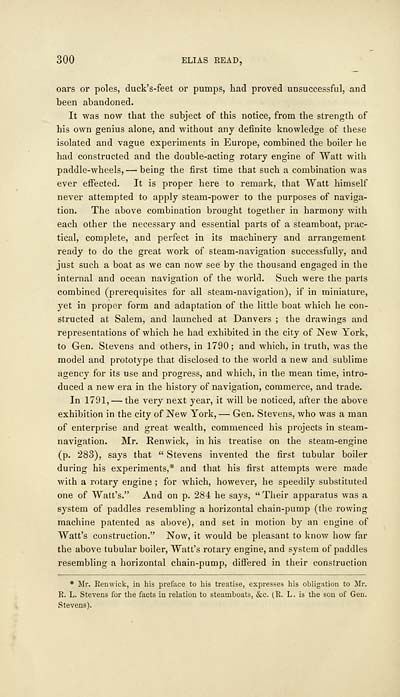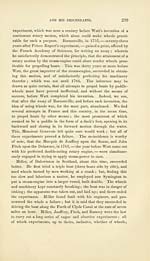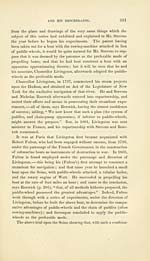History of the Reed family in Europe and America
(316) Page 300
Download files
Complete book:
Individual page:
Thumbnail gallery: Grid view | List view

300
oars or poles, duck's-feet or pumps, had proved unsuccessful, and
been abandoned.
It was now that the subject of this notice, from the strength of
his own genius alone, and without any definite knowledge of these
isolated and vague experiments in Europe, combined the boiler he
had constructed and the double-acting rotary engine of Watt with
paddle-wheels, — being the first time that such a combination was
ever effected. It is proper here to remark, that Watt himself
never attempted to apply steam-power to the purposes of naviga-
tion. The above combination brought together in harmony with
each other the necessary and essential parts of a steamboat, prac-
tical, complete, and perfect in its machinery and arrangement
ready to do the great work of steam-navigation successfully, and
just such a boat as we can now see by the thousand engaged in the
internal and ocean navigation of the world. Such were the parts
combined (prerequisites for all steam-navigation), if in miniature,
yet in proper form and adaptation of the little boat which he con-
structed at Salem, and launched at Danvers ; the drawings and
representations of which he had exhibited in the city of New York,
to Gen. Stevens and others, in 1790 ; and which, in truth, was the
model and prototype that disclosed to the world a new and sublime
agency for its use and progress, and which, in the mean time, intro-
duced a new era in the history of navigation, commerce, and trade.
In 1791, — the very next year, it will be noticed, after the above
exhibition in the city of New York, — Gen. Stevens, who was a man
of enterprise and great wealth, commenced his projects in steam-
navigation. Mr. Eenwick, in his treatise on the steam-engine
(p. 283), says that " Stevens invented the first tubular boiler
during his experiments,* and that his first attempts were made
with a rotary engine ; for which, however, he speedily substituted
one of Watt's." And on p. 284 he says, " Their apparatus was a
system of paddles resembling a horizontal chain-pump (the rowing
machine patented as above), and set in motion by an engine of
Watt's construction." Now, it would be pleasant to know how far
the above tubular boiler, Watt's rotary engine, and system of paddles
resembling a horizontal chain-pump, differed in their construction
* Mr. Eenwick, in his preface to his treatise, expresses his obligation to Mr.
R. L. Stevens for the facts in relation to steamboats, &c. (R. L. is the son of Gen.
Stevens).
oars or poles, duck's-feet or pumps, had proved unsuccessful, and
been abandoned.
It was now that the subject of this notice, from the strength of
his own genius alone, and without any definite knowledge of these
isolated and vague experiments in Europe, combined the boiler he
had constructed and the double-acting rotary engine of Watt with
paddle-wheels, — being the first time that such a combination was
ever effected. It is proper here to remark, that Watt himself
never attempted to apply steam-power to the purposes of naviga-
tion. The above combination brought together in harmony with
each other the necessary and essential parts of a steamboat, prac-
tical, complete, and perfect in its machinery and arrangement
ready to do the great work of steam-navigation successfully, and
just such a boat as we can now see by the thousand engaged in the
internal and ocean navigation of the world. Such were the parts
combined (prerequisites for all steam-navigation), if in miniature,
yet in proper form and adaptation of the little boat which he con-
structed at Salem, and launched at Danvers ; the drawings and
representations of which he had exhibited in the city of New York,
to Gen. Stevens and others, in 1790 ; and which, in truth, was the
model and prototype that disclosed to the world a new and sublime
agency for its use and progress, and which, in the mean time, intro-
duced a new era in the history of navigation, commerce, and trade.
In 1791, — the very next year, it will be noticed, after the above
exhibition in the city of New York, — Gen. Stevens, who was a man
of enterprise and great wealth, commenced his projects in steam-
navigation. Mr. Eenwick, in his treatise on the steam-engine
(p. 283), says that " Stevens invented the first tubular boiler
during his experiments,* and that his first attempts were made
with a rotary engine ; for which, however, he speedily substituted
one of Watt's." And on p. 284 he says, " Their apparatus was a
system of paddles resembling a horizontal chain-pump (the rowing
machine patented as above), and set in motion by an engine of
Watt's construction." Now, it would be pleasant to know how far
the above tubular boiler, Watt's rotary engine, and system of paddles
resembling a horizontal chain-pump, differed in their construction
* Mr. Eenwick, in his preface to his treatise, expresses his obligation to Mr.
R. L. Stevens for the facts in relation to steamboats, &c. (R. L. is the son of Gen.
Stevens).
Set display mode to:
![]() Universal Viewer |
Universal Viewer | ![]() Mirador |
Large image | Transcription
Mirador |
Large image | Transcription
Images and transcriptions on this page, including medium image downloads, may be used under the Creative Commons Attribution 4.0 International Licence unless otherwise stated. ![]()
| Histories of Scottish families > History of the Reed family in Europe and America > (316) Page 300 |
|---|
| Permanent URL | https://digital.nls.uk/94794411 |
|---|
| Description | A selection of almost 400 printed items relating to the history of Scottish families, mostly dating from the 19th and early 20th centuries. Includes memoirs, genealogies and clan histories, with a few produced by emigrant families. The earliest family history goes back to AD 916. |
|---|

